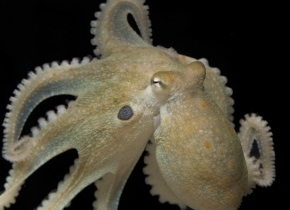

章鱼对MDMA的反应与人类很像。不出所料,基于其身体结构,章鱼是擅长拥抱的动物。安妮·斯尼德报道。
安妮·斯尼德(Annie Sneed)
翻译:张朵儿
审校:郭晓
When humans take the drug MDMA—best known as ecstasy—they feel a deeper connection to others—emotionally and physically. Because MDMA affects serotonin, a nervous system chemical.
当人类服用MDMA药物,也就是常说的摇头丸,他们会在情绪以及肢体层面上,感觉和他人有更深层次的联系。因为MDMA会影响一种称为血清素(又称5-羟色胺)的神经系统化学物质。
“Serotonin is one of the oldest neurotransmitters.” Gul Dolen, an assistant professor of neuroscience at Johns Hopkins University who studies social behaviors.
“血清素是最古老的神经递质之一。”约翰霍普金斯大学研究社会行为的神经科学助理教授古尔·多伦(Gul Dolen)说。
“It's been implicated in all kinds of functions, lots of them having nothing to do with social, and so we wanted to know, how long ago was serotonin's function really about encoding social behaviors?” So Dolen and her colleague did what any scientist would do: they gave MDMA to octopuses.
“它涉及到各种各样的功能,大多数与社交无关。所以我们想探究,血清素的功能在多久以前是真的与编码社会行为有关?”于是,多伦和她的同事做了科学家都会做的:他们给章鱼喂MDMA。
Octopuses are asocial creatures, and their last common ancestor with us lived more than a half billion years ago. Which made them a good test subject for the question at hand.
章鱼是一种不合群的生物,它们与人类最后的共同祖先生活在五亿多年前。因此,它们成了该问题合适的测试对象。
The researchers set up a simple test: “There’s a large chamber, which is basically an aquarium tank, divided it into three chambers. On one side, we put a little overturned flowerpot that's clear and plastic and has lots of holes in it. Underneath that overturned pot, we have a toy object, and on the other side, we have another overturned orchid pot, but this one has an octopus in it.”
研究人员设计了一个简单的测试:“现在有一个大房间,基本上是一个水族箱,将其分成三个房间。在其中一边,我们放了一个翻倒的透明塑料花盆,并有很多洞。盆底下,放了一个玩具;另外一边,我们放了另外一个翻倒的兰花盆,但这个里面有一只章鱼。“
The researchers put an octopus in the middle chamber and watched it swim around for thirty minutes. They measured how much it interacted with one side of the chamber—the one with the other octopus—versus the chamber with the toy. Then they soaked the test octopus in a beaker of MDMA , put it back in the aquarium and watched it for another thirty minutes. And what the researchers saw was weirdly similar to a human on MDMA:
研究人员将一只章鱼放在中间的房间,观察它游了三十分钟。他们测量了它对两边分别有玩具和章鱼的房间的互动程度。然后他们将测试对象浸泡在含有MDMA的烧杯中,之后将其放回水族箱中再观看三十分钟。结果,研究人员看到的与服用MDMA的人类非常相似:
“Before they received MDMA when they were interacting, they're very reserved, even when they're spending time in the social side, they are sort of mashing their bodies up against the side wall, and extending only one arm out to touch the flowerpot, and very tentatively touching with one arm…. After MDMA, all of the animals spent significantly more time in the side that had the other octopus in it. What's more is that the quality of their social interactions—they were much more loose in their body posturing, they were allowing several arms to touch the sides of the flowerpot, sort of hugging around the flowerpot, and exposing the bottom part of their body to the other octopus which, the way they were doing that, was suggesting they were exploring rather than any kind of aggressive posturing.”
“在接受MDMA之前,当它们进行互动时,它们非常保守。即使处于社交状态,它们只会将身体撞到侧壁上,只伸出一条触腕来触摸花盆,非常试探性地用那一只触腕来触摸......服用MDMA之后,所有测试对象都明显地在有章鱼的一侧花费更多的时间。此外,它们的社交互动质量明显提高。它们的身体姿势更放松,会伸出多个触腕触摸花盆的侧面,有点像是在拥抱花盆,并将它们身体的底部部分暴露给另一只章鱼,它们这样做,意味着它们正在探索,而并不是任何侵略性的姿势。“
These observations indicate that serotonin began playing a role in animals’ social behavior more than 500 million years ago.
这些观察结果表明,血清素在5亿多年前就开始在动物的社会行为中发挥作用。
Dolen says these findings could help scientists better understand social behavior, as well as give clues about possible treatments for serotonin-related human conditions like schizophrenia and PTSD.
多伦提到,这些研究结果可以帮助科学家更好地了解社会行为,并为治疗血清素相关人类疾病(如精神分裂症和创伤后应激障碍)提供线索。
Meanwhile, we’ve learned—not surprisingly, given their anatomy—that octopuses are excellent huggers.
同时,我们发现,不出所料的是,基于其身体结构,章鱼是擅长拥抱的动物。
 京公网安备11010502039775号
京公网安备11010502039775号